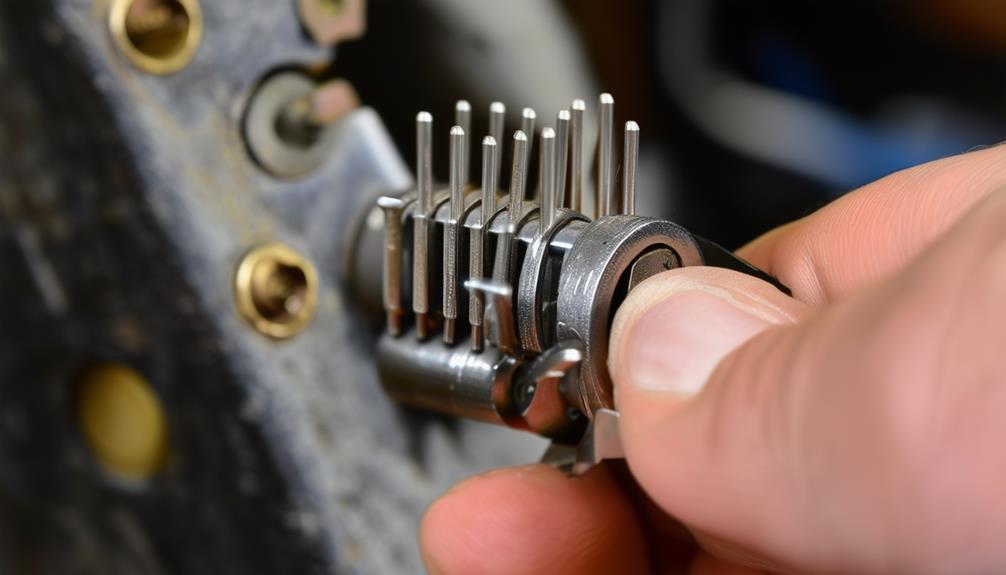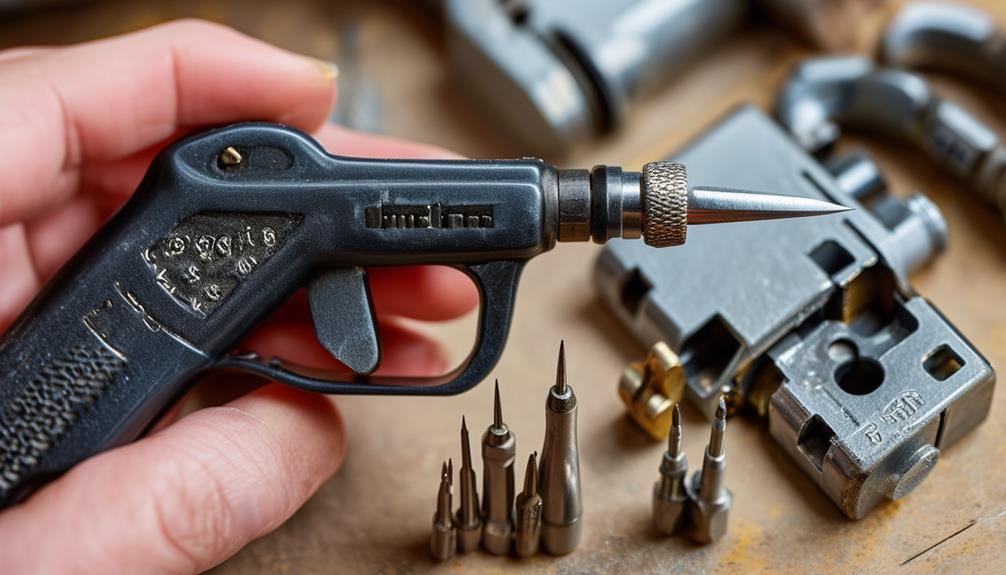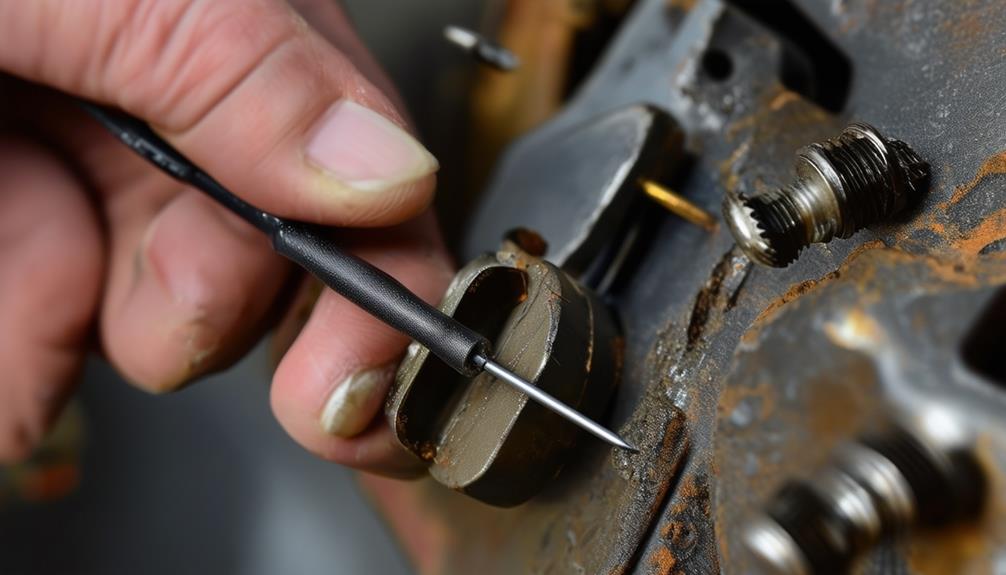To master advanced lock picking techniques, start by perfecting bump key skills, aligning pins with precision using a bump hammer. Explore wafer locks, lifting tumblers to access with the right tools and tension. Immerse yourself in tubular locks, understand circular keyways with specialized picks. Use Sparrows tension tools smartly, maintain pressure for effective manipulation. Decode combination locks systematically, listen for clicks to reveal the code. Tackle security pins by mastering feedback sensitivity and overcoming challenges. Get creative, repurpose everyday items for lock picking. Discover more techniques and tools for an enhanced lock picking journey.
Key Takeaways
- Practice bump key techniques for pin tumbler locks with precision and patience.
- Master advanced pin manipulation by understanding pin interactions and using specialized tools.
- Learn to overcome security pins like spool, serrated, and mushroom pins effectively.
- Utilize suitable tools and techniques for wafer locks, focusing on precise wafers manipulation.
- Develop feedback sensitivity for improved tension control and successful lock picking outcomes.
Mastering Bump Key Techniques

To master bump key techniques, you must first understand the key components of this method. Bump keys are specially crafted keys that can manipulate pin tumbler locks by using a bumping technique, which is one of the fundamentals of lock picking.
The goal is to align the pins within the lock cylinder to allow the key to turn and open the door. To create a bump key, you'll need a blank key that fits the lock you want to access, and you must file down the key's teeth to specific depths.
The next step involves inserting the bump key slightly into the lock and striking it with a bump hammer or a similar tool while simultaneously turning the key. The force from the bump will jostle the pins, causing them to jump momentarily and create a brief window for the key to turn and activate the lock.
Keep in mind that mastering bump key techniques requires practice, patience, and precision to successfully open various pin tumbler locks.
Understanding Wafer Locks

You're about to learn about the intricate components of wafer locks and effective picking techniques for these types of locks.
Wafer locks consist of a series of flat, sliding wafers that must be aligned correctly to allow the lock to turn, making them distinct from traditional pin tumbler locks.
Understanding the security measures and vulnerabilities of various locks will give you insight into how they can be manipulated.
Wafer Lock Components
Understanding the components of wafer locks is essential for anyone looking to explore lock picking techniques. Wafer locks are commonly found in various types of locks, including padlocks, filing cabinets, and some automobile locks. These locks consist of several key components that interact to secure the lock mechanism and prevent unauthorized access.
Let's break down the key components of a wafer lock in the table below:
| Component | Description |
|---|---|
| Wafers | Thin, flat metal pieces that obstruct the lock's rotation unless aligned properly. |
| Shell | Outer casing that houses the internal components of the lock. |
| Plug | Rotating cylinder that houses the keyway and wafers. |
| Key Pins | Pins that match the cuts on the key to allow the lock to turn. |
| Springs | Small, coiled springs that push the wafers into the plug when the key is not inserted. |
Understanding how these components work together is vital for developing effective lockpicking techniques for experts. By familiarizing yourself with the anatomy of a wafer lock, you can enhance your skills in manipulating these locks for various purposes.
Picking Techniques for Wafers
When picking wafer locks, mastering the specific techniques tailored to these locks is vital for successful manipulation. Understanding the inner workings of wafer locks and employing advanced lock picking techniques will increase your chances of efficiently opening them.
To begin, it's essential to grasp how wafer locks function. These locks contain wafer tumblers that must be lifted to the correct height to align the inner mechanism and open the lock. Utilizing a pick tool with a suitable design and applying the right amount of tension is key to moving the wafers into place.
When engaging with wafer locks, one effective technique involves using a rocking motion with your pick to lift the wafers incrementally. By gently rocking the pick while maintaining tension, you can gradually manipulate each wafer to the correct position.
This method requires patience and finesse but can yield successful results when executed skillfully.
Incorporating these advanced lock picking techniques tailored for wafer locks will enhance your proficiency in manipulating these mechanisms effectively.
Exploring Tubular Lock Picking

Ready to explore the intricate world of tubular lock picking? Tubular locks are known for their circular keyways and pins, making them a unique challenge for lock picking enthusiasts.
To tackle these advanced lockpicking methods, you'll need specialized tools such as tubular lock picks or tension tools designed specifically for these locks. Regular practice with a practice lock can greatly improve your technique and increase your chances of success.
When approaching a tubular lock, it's crucial to understand the internal mechanism. Tubular locks contain pins that align along the circular keyway, requiring precise manipulation to set them in the correct position.
Using a tubular lock pick, you can exert pressure on these pins individually, gradually moving them into place to open the mechanism.
To successfully pick a tubular lock, patience and finesse are key. By gently rotating the pick and feeling for subtle movements in the pins, you can gradually manipulate them into position.
With practice and a steady hand, mastering tubular lock picking can become a rewarding skill in your lock picking repertoire.
Advanced Sparrows Tension Tool Usage

To elevate your lock picking skills, focus on mastering advanced Sparrows tension tool usage.
Understanding the nuances of advanced lock picking techniques is essential for achieving proficiency.
Guarantee proper tension control to navigate the delicate balance between too much force and not enough.
Precision in tool placement and mastering feedback sensitivity are key components to successfully manipulating the pins within the lock.
Proper Tension Control
With proper tension control being vital in advanced lock picking techniques, mastering the use of Sparrows tension tools can greatly enhance your skills.
When utilizing Sparrows tension tools, keep the following key points in mind:
- Consistent Pressure: Apply steady and consistent pressure on the tension wrench to create the necessary tension in the lock. Avoid applying too much force as it may lead to oversetting pins, making it harder to set them correctly.
- Feedback Interpretation: Pay close attention to the feedback you receive from the lock as you apply tension. Learn to differentiate between binding pins and set pins, adjusting your pressure accordingly to manipulate the pins effectively.
- Adaptability: Practice adjusting the amount of tension based on the specific lock you're working on. Different locks may require varying levels of tension, so being adaptable and responsive to feedback is essential for successful lock picking.
Precision in Placement
When aiming to master advanced lock picking techniques, achieving precision in placement with Sparrows tension tools is paramount. The key to successful lock picking lies in the delicate balance of applying just the right amount of pressure in precisely the correct spot.
With Sparrows tension tools, you have the advantage of fine-tuning your touch to achieve the precision in placement needed to manipulate the pins inside the lock effectively.
To enhance your lock picking skills, practice placing the tension tool with utmost precision at the bottom of the keyway. Ascertain that you apply steady but gentle pressure to create the necessary tension without accidentally binding the lock.
Mastering Feedback Sensitivity
Developing a keen sense of feedback sensitivity is essential when utilizing advanced Sparrows tension tools for lock picking.
Mastering lockpicking techniques requires a deep understanding of how to interpret the subtle feedback provided by the lock. Here are three key points to help you enhance your feedback sensitivity:
- Lighten Your Touch: Adjust the pressure on the tension wrench to the bare minimum needed to maintain control over the core. This delicate touch allows you to feel even the slightest movements within the lock.
- Pay Attention to Feedback: Focus on the feedback you receive from the lock as you apply tension. Learn to distinguish between different sensations such as clicks, binding pins, or subtle rotation movements.
- Practice Patience: Developing feedback sensitivity takes time and practice. Be patient with yourself and allow for mistakes as you learn to interpret the feedback accurately.
Decoding Combination Locks

Cracking a combination lock requires a keen eye and steady hands. Decoding combination locks involves a systematic approach to uncovering the correct sequence of numbers. Start by applying slight tension to the shackle while turning the dial in one direction.
It's important to understand the types and mechanisms of locks to better anticipate how each lock may respond. Listen for subtle clicks or changes in resistance as you pass each number. These can indicate the correct code. If you miss any clicks, reset the dial and start again. Pay close attention to any irregularities in the lock's behavior.
As you progress through the numbers, make note of any potential candidates for the code. Once you have identified all possible numbers, try different combinations until the lock opens.
Remember to be patient and methodical in your approach. Decoding combination locks is a delicate process that requires precision and focus. With practice, you can develop the skills needed to decode various types of combination locks effectively.
Utilizing Lock Picking Guns

Utilizing lock picking guns can markedly expedite the process of opening certain types of locks.
These tools are commonly used in professional lock picking scenarios where speed is vital. The Locksmith's Guide to Pick Guns emphasizes the significance of understanding the mechanics of these tools to enhance effectiveness.
Here are three key points to take into account when using lock picking guns:
- Selecting the right tool: Lock picking guns come in various sizes and designs to suit different types of locks. It's essential to choose the appropriate gun that fits the lock you're trying to open. Familiarize yourself with the different options available to enhance your success rate.
- Mastering the technique: Operating a lock picking gun requires skill and precision. Practice on different locks to improve your technique and efficiency. Understanding the mechanics of the gun and how it interacts with the lock will help you become more proficient in using it.
- Respecting the tool: Lock picking guns are powerful instruments that should be handled with care. Avoid excessive force that could damage the lock or the gun itself. Treat the tool with respect to prolong its lifespan and guarantee successful outcomes in your professional lock picking endeavors.
Overcoming Security Pins

When faced with locks equipped with security pins, your lock picking skills are put to the test at a higher level of complexity.
Security pins are designed to make it more challenging to pick a lock by introducing variations in pin shapes, sizes, and mechanisms. To enhance your security measures, consider implementing pick-resistant locks that can deter unauthorized access.
To overcome security pins, it's vital to understand the different types that exist. The most common security pins include spool pins, serrated pins, and mushroom pins.
Spool pins have a narrower center, causing a false set when not properly aligned. Serrated pins have small serrations that catch on the shear line, making it difficult to set them. Mushroom pins have a larger top that can get stuck at the shear line if not lifted correctly.
To tackle these security pins effectively, it's essential to use the right tension and feel for feedback from the pins. Practice and patience are key when overcoming security pins, as mastering these techniques will enhance your lock picking skills considerably.
Improvising With Everyday Items

To overcome challenges when faced with locks equipped with security pins, improvising with everyday items can be a valuable skill to have in your lock picking arsenal.
Knowing various techniques from a beginner's guide can also enhance your ability to adapt. In the world of professional lockpicking methods, being able to think on your feet and utilize common items creatively can make a significant difference in your success rate.
Here are three items you can use for improvising when traditional tools aren't available:
- Bobby Pins: These can be reshaped and used as makeshift lock picks or tension wrenches in a pinch. With a little practice, bobby pins can prove to be versatile tools for accessing locks with security pins.
- Paperclips: Straightening out a paperclip can create a simple yet effective lock pick. Additionally, bent paperclips can be used as tension wrenches, offering flexibility in your approach to different lock mechanisms.
- Safety Pins: Similar to bobby pins, safety pins can be adjusted to act as lock picks or tension wrenches. Their small size and malleability make them handy for intricate lockpicking tasks.
Advanced Pin and Tumbler Manipulation

In the domain of lock picking, mastering advanced pin and tumbler manipulation is an essential skill that separates amateurs from seasoned professionals. Understanding the intricate mechanisms of pin and tumbler locks is vital for successfully manipulating them.
Advanced techniques involve a deep comprehension of how each pin interacts with the corresponding driver pin and shear line within the lock cylinder. Familiarity with pin tumbler lock picking techniques can greatly enhance your understanding of these interactions.
To excel in advanced pin and tumbler manipulation, it's imperative to hone your tactile sensitivity and precision. By applying varying amounts of tension to the lock's plug while carefully manipulating each pin, you can feel for subtle feedback that indicates progress towards releasing the mechanism.
Expertise in this area allows you to navigate security pins, master key systems, and other complex lock variations with finesse.
Additionally, advanced practitioners often utilize specialized tools like high-quality picks and tension wrenches tailored to specific lock types. These tools, coupled with a deep understanding of lock mechanisms, empower professionals to navigate challenging locks swiftly and effectively.
Mastering advanced pin and tumbler manipulation elevates your lock-picking capabilities to a level where even the most sophisticated locks can be conquered.
Frequently Asked Questions
Can Lock Picking Damage the Lock or Door?
Lock picking can potentially damage the lock or door if done improperly.
Applying excessive force or using the wrong tools can lead to broken pins, springs, or other components within the lock.
It's essential to practice proper technique and use the right tools to minimize the risk of causing damage.
Always remember to approach lock picking with caution and precision to avoid any unnecessary harm to the lock or door.
Is Lock Picking Legal for Personal Use?
Lock picking for personal use is legal in many places as long as you aren't trying to break the law.
It's like a spare key you carry in case you get locked out. In fact, 4 out of 5 locksmiths say lock picking is a valuable skill to have.
Just remember, always use your skills responsibly and ethically.
Practice on your locks and stay within the boundaries of the law.
How Do You Practice Lock Picking Safely?
To practice lock picking safely, start by using transparent practice locks to see the inner workings.
Always guarantee you have permission to practice on locks you don't own.
Practice in a well-lit area with proper tools to avoid accidents.
Take breaks to prevent frustration and maintain focus.
Finally, never use your skills for illegal activities.
Can Lock Picking Be Used for Emergencies?
Just like a key opens a door, lock picking can be a valuable skill in emergencies.
In situations where traditional methods fail, knowing how to pick a lock might provide access to essential resources or help.
However, it's vital to use this skill ethically and legally.
Always remember to prioritize safety and follow regulations when considering using lock picking in emergency scenarios.
What Are the Ethical Considerations of Lock Picking?
When considering lock picking, it's essential to ponder the ethical aspects. Breaking into someone's property without permission is illegal and unethical.
Lock picking should only be used for lawful purposes like in emergency situations or by professionals in the locksmith field. Always obtain appropriate training and certifications to guarantee you're using lock picking tools responsibly and ethically.
Conclusion
To sum up, mastering advanced lock picking techniques is like unraveling a complex puzzle with precision and skill. By understanding the intricacies of different lock types and utilizing specialized tools, you can overcome security measures and open doors of opportunity. Remember, practice makes perfect, so keep honing your skills and expanding your knowledge to become a true locksmithing virtuoso. Happy picking!









